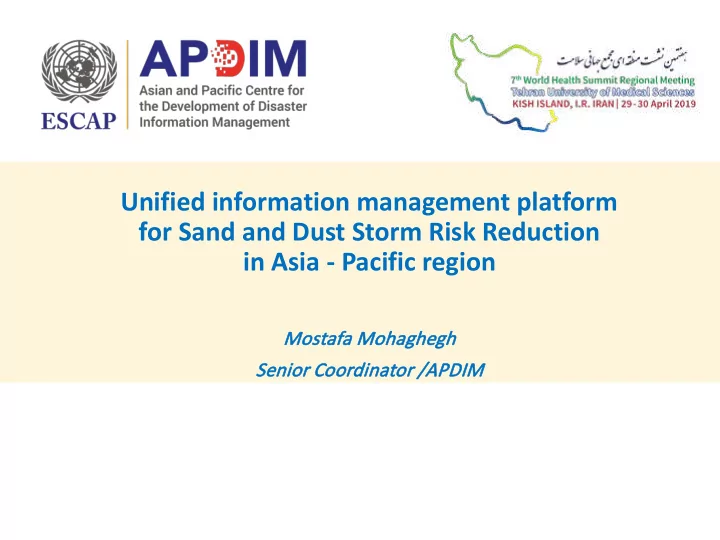

Unified information management platform for Sand and Dust Storm Risk Reduction in Asia - Pacific region Mostafa fa Mohagh ghegh gh Se Seni nior C Coordi dina nator /APDI DIM
Essential Concepts ﯽﺳﺎﺳا ﻢﯿھﺎﻔﻣ 1- ﺎﯾﻼﺑ و ثداوﺣ ﮏﺳﯾر لدﻣ رد ﯽﻧﺎﮭﺟرﯾﯾﻐﺗ Global Risk Pattern ﯽﻧﺎﮭﮔﺎﻧ و ﯽﺟﯾردﺗ ثداوﺣ فﻠﺗﺧﻣ رﺎﺛآ - 2 Sudden-onset v Slow-onset - هدرﺗﺳﮔ و مﮐارﺗﻣ یﺎھ ﮏﺳﯾر 3 Extensive v Intensive ﯽﮑﯾزﯾﻓ ﮫﻧﺎﮔرﺎﮭﭼ یﺎھ یرﯾذﭘ بﯾﺳآ رﺛا رد ثداوﺣ ﮏﺳﯾر ﯽﮕﺗﺷﺎﺑﻧا , - 4 ﯽﻋﺎﻣﺗﺟا , ﯽطﯾﺣﻣ تﺳﯾز و یدﺎﺻﺗﻗا Risk Accumulation (I
ﮫﻟﺰﻟز ﺮﺛارد ﻒﻠﺘﺨﻣ یﺎھرﻮﺸﮐ ﮫﻧﻻﺎﺳ نﺎﯾز ﻂﺳﻮﺘﻣ , ﻞﯿﺳ , ﯽﻣﺎﻧﻮﺳ و نﺎﻓﻮط Iran (Islamic Republic of) 4,859 Expected future disaster losses annualized over the long term
ﺎﯾﻼﺑ و ثداﻮﺣ ﮏﺴﯾر ﯽﮕﺘﺷﺎﺒﻧا Ri Risk Accumulatio ion n The risk accumulates over the years ― It’s a • slow onset process. • One hazard triggers another in specific context of arid and semi-arid regions. • Droughts, typically associated with vegetation decline and drier soils, frequently result in greater sand and dust storm activity. Cause and effects of risk accumulation cover a • large and spatially linked geography. The hypersaline Lake Urmia in north western Islamic Republic of Iran lost 90 per cent of its surface area between July 1998 and June 2014, which resulted in desertification, and sand and dust storms.
Water stress increasingly severe in high-risk areas associated with High sand and dust High sand and dust drought, land storm risk areas – storm risk areas – North and East Asia degradation, South West and Central Asia desertification and sand and dust storms. Source: Asia-Pacific Disaster Report 2017
د ﮫﯿﺳﻮﻧﺎﯿﻗا و ﺎﯿﺳآ رد ﯽﻤﯿﻠﻗا و ﯽﯾاﻮھ و بآ ثداﻮﺣ ﺮﻄﺧ یﺎﻤﻧرو ) نﺎﻓﻮط , ﻞﯿﺳ , ﯽﻟﺎﺴﮑﺸﺧ , رﺎﺒﻏودﺮﮔ ( Regional cooperation is the key for building resilience to cross border Weather and climate risk landscape disasters and climate change - Cyclones, floods, drought, sand and dust storms
ﮫﯾﺳوﻧﺎﯾﻗا و ﺎﯾﺳآ رد لﯾﺳ تدﻣ دﻧﻠﺑ رﺎﺛآ *So *Source: ESC ESCAP P (2016 2016) Disas aster ers i in A Asia a an and t the P e Pac acific: 2015 2015 Year ear i in Rev eview ew According to the World Resources Institute (2015), nearly 80% of the global population exposed to flood risk lives in 15 countries. Of these, 10 countries are in the Asia-Pacific region.
یزﺮﻣاﺮﻓ یﺎھ ﻞﯿﺳ , یﺎھﻮﯾرﺎﻨﺳ 2030-2015 A substantial increase in $5.2B $1.5B flood losses under both $1B moderate and severe climate Indus China, Pakistan and India scenarios. $1.5B $1B $0.9B China, India, Bangladesh and Amur China and Russian Federation Pakistan will experience two to three times more in flood $34.7B $1.9B $1B losses $0.9B Mekong $16.5B Cambodia, China, Lao PDR, The transboundary flood Myanmar, Thailand and Viet Nam losses will range from 1.2 to 6 $6.3B times more in the major river- basins Ganges-Bramaputra-Meghna Bangladesh, Bhutan, China and India
دﺎﺟﯾا مﻠﻋ نﺎﯾﻣ طﺎﺑﺗرا , و یراذﮕﺗﺳﺎﯾﺳمادﻗا Science , Policy , Action Nexus Propose and reach Understand and Implement agreed Monitor, learn and consensus on diagnose problems action scale up solutions Science Policy Action Assessment of sand and dust Country action plans Regional cooperation storms framework Investment projects Research, measure and assess Country-level action Capacity building network Innovation and knowledge network Dust storm fund and facilit y Monitoring and early warning system
APDIM strategic plan Three pillars conveying APDIM’s thematic priorities Information and Regional information Capacity knowledge services for cross- development border disasters repository Regional capacity Regional repository development hub Specialized services of databases, for exchange of (geospatial & information and expertise, statistical) for cross- knowledge experiences and border disasters knowledge Regional hub of new Demand driven and Regional tools, techniques customized training information and standards for services to address (maps & databases) information information and for cross-border management knowledge gaps disasters
Information and knowledge repository pillar Establishing regional cloud- based metadata platform • Partnership at regional level with UNDP, IRIDeS under the Global Centre for Disaster Statistics (GCDS) for complementing global and regional linkage of disaster information and data • NCC provide technical advice on format of geospatial information and platform configuration following UN-GGIM • APDIM is developing the Asia-Pacific Disaster Risk Atlas • Operationalize the Atlas as regional online repository of multi-hazard risk information related to cross-border disasters
Capacity development programme focusing on Sendai Framework monitoring and disaster loss databases o National training on Sendai Framework Monitoring in the Islamic Republic of Iran and Pakistan as initial pilot countries in 2019 respectively with NDMO of Iran and NDMA of Pakistan and UNCTs, in partnership with UNISDR o Capacity development on retrofitting of disaster loss databases in the Islamic Republic of Iran with NDMO and UNCT, in partnership with UNDP/GCDS o Regional training programmes on disaster information management in multi-hazard risks in partnership with regional and national centres of excellence
APDIM’s Work: Sand and Dust Storms • Multi-hazard risk assessment • Alert system • Partnerships/ network
Information services for cross-border disasters pillar Regional slow-onset hazards network and alert system, with initial focus on sand and dust storm • ESCAP/APDIM analytical report on Sand and Dust Storms in Asia and the Pacific provided regional framework for combatting sand and dust storms • Built partnership network for slow- onset and cross-border disasters. Capitalize on UNEP, UNCCD, WMO, UNDP and UN Coalition on Sand and Dust Storm • Implementation plan to develop a regional network and SDS alert system, starting with subregional South-West and Central Asia
مرﮑﺷﺗﻣ ﺎﻣﺷ ﮫﺟوﺗ زا Mostafa.mohaghegh@un.org
Recommend
More recommend